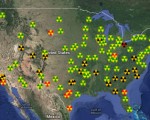Hi Rob,
In your newsletter this week, you said, “The scaremongering about Fukushima is grossly overblown,” and provide a link to this site, in which the author assures us that it’s OK to eat fish from the Pacific Ocean as long as they’re not from Japan, and declares that radiation reaching the West Coast “will not be dangerous.”
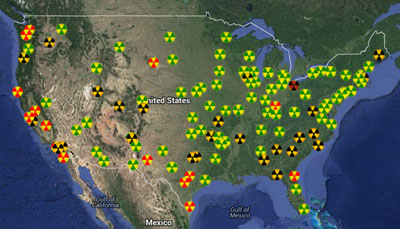 |
|
Radiation map of the continental United States from December 2013, showing increased levels toward the western U.S., closer to Japan. The data is from the Nuclear Emergency Tracking Center, a private organization that aggregates government data.
|
The author states almost gleefully, “I certainly feel safe eating sustainable seafood from the Pacific and so should you.”
My problem with your statement is that as far as the public is concerned, you’re saying don’t worry, and you’re not asking any questions at all. “Grossly overblown” does not even suggest you believe there might be a potential question.
Why are you eager to spread the word that Fukushima is safe, or safe until proven dangerous? The problem does not have to be imminent disaster and the threat of relocation. Fukushima will proceed as a slow-motion crisis as the radiation gradually diffuses from the wreckage to the rest of the environment, concentrating in living creatures and working its way up the food chain. We have been covering this since the beginning — it’s a very serious situation, and it’s not getting any better.
There is no safe level of radiation exposure. Additionally, not everyone similarly situated gets the same exposure from an incident. Someone who eats one contaminated fish is going to have a problem, whereas someone who does not eat that fish won’t have that particular problem. But there is no way to predict who will and who will not eat that one fish. Every fish is not being tested.
“Don’t eat fish from Japan” is ridiculous advice. Everyone who eats sushi eats fish from Japan, and it’s obvious that some fish from Japan will be improperly classified and sold as non-Japanese product.
Vegetarians are not immune. Many edible plants collect and concentrate radiation. This creates direct exposure and it moves up the food chain, ending up in dairy products and elsewhere.
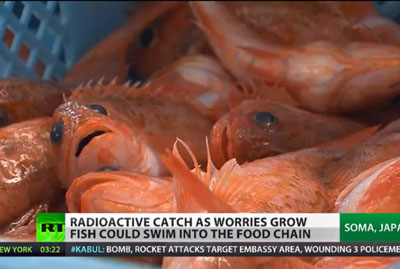 |
|
Image from Russian Television International report on concerns about contaminated fish getting into the food supply.
|
Not everyone’s body responds to exposure the same way. Some people, such as immune-compromised people, and cancer patients on chemotherapy, are much more vulnerable. Children and small animals are more vulnerable.
Further, we all have a body burden of artificial radiation, from X-rays, radiotherapy, nuclear bomb testing that exposed the entire U.S. population, contaminated food from those tests that was distributed to the population, leaks from nuclear reactors, microwave ovens, irradiated foods, cellular telephones and cell towers.
The entire West Coast is receiving radiation from the Manhattan Project dumps at Hanford, WA (via water table contamination), which then goes into the Columbia River and is transported to the Pacific and carried up and down the coast by currents.
So we already have a lot of radiation we’re dealing with; let’s not forget increases in UV radiation exposure from ozone depletion. Therefore, whatever we get from Fukushima is adding to an already serious problem. Since when does adding any more make it OK?
Since when, with the cancer rate hovering at around 50%?
I do not need to present any evidence of any specific danger to be ‘right’. I don’t have to find a thousand contaminated fish or even one of them. My role is to educate people about the precautionary principle: what do you believe, and what do you do, in the face of missing or incomplete information, especially when there is a known point source, a known contamination crisis?
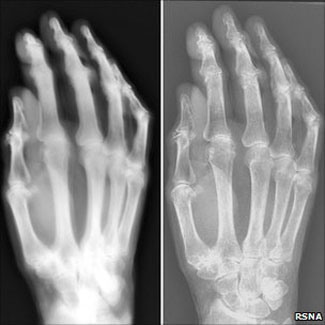 |
|
Ordinary X-rays add to our total body burden of radiation. Each dose adds to what is already there.
|
I am pointing out that the blanket conclusions or assurances of safety cannot be right. And this is what the nuclear industry and its proponents always do. The exposure is always the equivalent of a dental X-ray.
Blanket assurances don’t stand up when there is a known deadly substance present, combined with insufficient data, a data blackout, a propaganda stream, conflicting data or facts plainly indicating a problem — such as the established fact of all Pacific tuna being contaminated.
In any environmental incidents I’ve ever covered or heard of, from Love Canal to 9/11 to Three Mile Island to SUNY New Paltz, the goal of officialdom is to minimize the perception of danger.
The official position is always that something is safe until proven dangerous, and that anyone talking about the dangers is an alarmist. The official position is that a little is OK and it’s fine if you only kill a few people (that’s known as risk assessment).
The popular position is usually “please, tell me it’s safe.” The precautionary principle says, you must do a worst-case analysis. However, if that were applied to nuclear power, it could not exist, because the worst case, which keeps happening, is so bad that society cannot actually deal with it.
Fukushima cannot be cleaned up; this mess will torment hundreds of generations into the future, who will never know a moment of benefit from the electric power that was generated by the plant.
You said: “Further evidence of sloppy research fed by emotion, not objective reporting: You say that Woods HHole is ‘chopping wood for the nuclear industry’. Do you have even a shred of evidence for that claim?”
In my experience, anyone who repeats knowing lies about a nuclear incident is doing the work of the nuclear industry, particularly if they bear scientific credentials. It does not matter if somewhere else they say they have their concerns; that merely creates the appearance of balance. Direct evidence of collusion is unnecessary. The fingerprints are in the point of view that supposedly objective scientists share with profit-driven, verging-on-psychotic proponents of nuclear power — that all is well. Don’t worry. I would feed that to my kid.
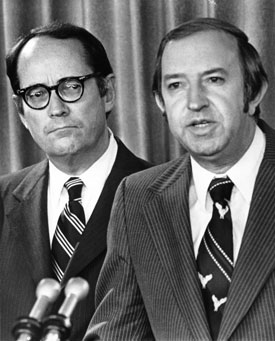 |
|
In 1980, then-Gov. Dick Thornburgh and Harold Denton of the Nuclear Regulatory Commission talk to the press about the Three Mile Island partial meltdown. Photo: Univ. of Pittsburgh.
|
Woods Hole Oceanographic Institute knows better than to declare the fish and the oceans safe without even saying there are real questions. By definition that is deceptive.
On their FAQ page, they leave out issues like biomagnification, as well as migratory fish and the known extent of the plume. They are taking a position used by polluters in the ’60s and ’70s that all you need to do is water down the toxins. Then through bioconcentration, various biota gather it right back up the food chain, where we humans reside at the very top.
Any responsible scientist who wants to minimize the danger would say, “based on the data, we don’t know,” but the problem with that is there is a lot of data indicating a widespread, uncontained problem.
The ethical position when there is missing or insufficient data is to tell people that they must take the time to inform themselves, and make their own decision once admitting that there are certain variables. But we do know enough to know there is a serious problem.
The ethical position is not to declare the story overblown. Declaring a rumor overblown is one thing — but you would have to specifically debunk THAT specific rumor to do so.
Just because there were a series of Internet memes suggesting much worse dangers, some of which may have been exaggerated, does not make them wrong. They are based on something real — Unit 3 is releasing steam, as confirmed by TEPCO; Unit 3 melted down; it has MOX plutonium fuel, and a lot of old assemblies in the spent fuel pool.
You wrote: “I wonder if you think that Scientific American, National Geographic, and the National Academy of Sciences have joined Woods Hole in chopping wood and carrying water for the nuclear industry. They all have downplayed the dire doomsday prophecies circulating on Facebook, the Internet, and the Alex Jones radio show.”
This is not a case of either NAS or Alex Jones is right. That is a false dichotomy. As regards Scientific American, they have lied about dioxin before, along with many other ‘reputable’ journals repeating a series of fraudulent studies paid for by Monsanto. None of the secondary sources ever retracted their articles once the studies were proven fraudulent in later litigation.
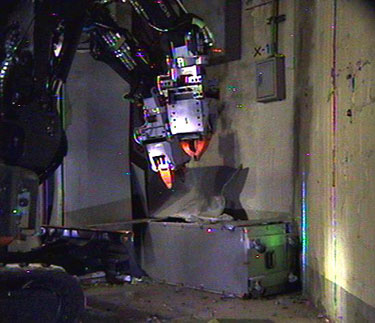 |
|
Robots working on the first floor of the Fukushima Unit 3 reactor building, a place too contaminated for humans to go.
|
National Academy of Sciences is all over the map. What they say is not true just because they say it; they are an entity very close to the government and must respond to political forces, like most other large institutions. One recent case I know about is their declaring the anti-HPV Gardasil vaccine safe, when there are numerous reports of severe reactions and some deaths in young girls who got the injection. On the other hand they are realistic about climate change.
Supposedly credible sources may downplay Alex Jones but that does not make him wrong. They may downplay the increased radiation levels that citizen monitors are reporting, and the leaking steam from the MOX wreckage at Unit 3.
The thousands of tons of spent fuel on the Fukushima site present a real and ongoing threat, and if there is an expanded incident, it will be too late to prepare after the fact.
Three hundred tons of radioactive water each and every day leaking into the Pacific Ocean is not a joke. It is nothing to minimize. All that radiation goes somewhere, and it’s showing no signs of stopping.
Fukushima is in the path of typhoons, earthquakes and tsunamis. There are thousands of tons of uranium and plutonium fuel on site. All of the buildings are in bad shape and most could not withstand another serious quake. There is nothing stable or safe about this situation, and it’s so toxic that reporters cannot even get near it for more than an hour.
Meanwhile, Japan has passed a law making it a crime to reveal or report on ‘state secrets’, including Fukushima. And to give one example how that works in the United States, MSNBC, the closest thing to real TV news, is co-owned by GE, the company that manufactured the reactors. So we cannot trust what is in the media.
That is what we need to be talking about.
With love,


